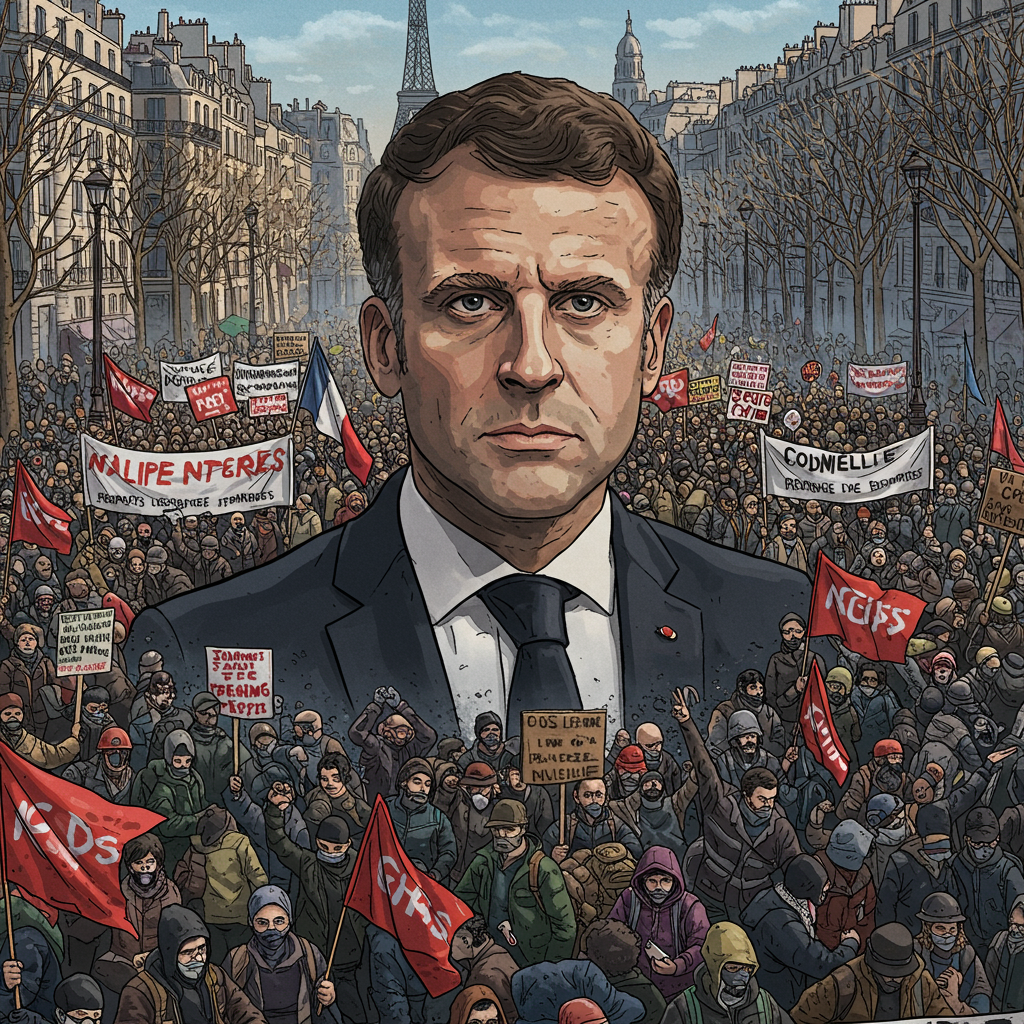Widespread France strikes have plunged the nation into deep political and social turmoil, as hundreds of thousands of workers united to protest the government’s stringent budget cut plans. These massive demonstrations highlight escalating public anger against austerity measures and present a formidable challenge to President Emmanuel Macron’s leadership, whose approval ratings have hit new lows. Barely a week into his tenure, newly appointed Prime Minister Sébastien Lecornu finds himself at the forefront of this national reckoning, grappling with a deeply divided parliament and an enraged populace demanding genuine change.
A Nation on Edge: The Scale of French Protests
Thursday witnessed an extraordinary outpouring of discontent across France. Estimates of participants in the nationwide France strikes varied, with trade unions claiming a turnout of one million people and the Interior Ministry putting the figure at around 500,000. To manage the widespread protests, authorities deployed a massive security presence, mobilizing 80,000 police officers across the country, including drones, armored vehicles, and water cannons. By late afternoon, over 140 people were detained, with some reports citing up to 309 arrests nationwide as authorities sought to contain the unrest.
The industrial action caused significant disruption to daily life and public services. In Paris, many metro lines were shut, while major delays affected suburban rail services. Protesters effectively blocked bus depots in cities like Lille and erected road barricades in other urban centers, bringing traffic to a standstill. Education was severely hit, with approximately a third of teachers walking out and students blocking entrances to schools and universities, chanting slogans. Pharmacists showed overwhelming solidarity, with an estimated 98% of pharmacies remaining closed in a powerful display of collective action.
The Spark: Unpopular Budget Cuts and Spiraling Public Debt
At the heart of this national upheaval lies an unpopular proposal for €44 billion (£38 billion) worth of budget cuts. These austerity measures, initially drafted by former Prime Minister François Bayrou’s short-lived government, aimed to tackle France’s soaring public debt. The nation’s financial health is precarious, with public debt currently equivalent to almost €50,000 per French citizen and a national debt standing at over €3.3 trillion, roughly 114% of its economic output. Last year’s deficit reached 5.8% of GDP, nearly double the European Union’s 3% ceiling, prompting the government to justify the cuts as essential to restore fiscal balance.
However, these proposed cuts have ignited a furious backlash from unions and citizens alike. The public perceives them as an unjust burden on ordinary citizens, while the wealthy continue to prosper. This widespread discontent is not new; both of Lecornu’s immediate predecessors, Bayrou and Michel Barnier, saw their governments collapse over similar budget proposals that favored substantial cuts. The persistent inability to reconcile economic necessity with public welfare underscores the deep-seated nature of political instability France.
Voices of Discontent: What Protesters Demand
The core demands of the striking workers and trade unions are clear: increased spending on vital public services France, higher taxes for the wealthy, and the complete cancellation of the outlined budget cuts. Protesters articulated a profound sense of injustice and weariness with government policies. Cyrielle, a 36-year-old IT worker, voiced her opposition to both Macron’s and Bayrou’s economic and social policies, advocating for greater investment in public services and culture, suggesting that wealthier individuals should contribute more.
Union leaders echoed these sentiments forcefully. Sophie Binet, head of the prominent CGT union, emphasized the necessity of strong collective action to compel the government and employers to abandon policies that disproportionately serve the richest segments of society. Retirees, such as 85-year-old Florence, explicitly aimed to reverse previous controversial reforms, like the pension age increase, arguing that they simply could not continue working until 64. Other protesters lamented the rising cost of living, struggling wages, and the systematic erosion of cherished public services like free schools and public hospitals. As one transport worker, Nadia Belhoum, put it, “There’s no more money, a high cost of living…people [are] agonizing, being squeezed like a lemon.”
Political Turmoil: Macron’s Government in Crisis
The current wave of France strikes places immense pressure on President Emmanuel Macron, whose popularity has plummeted. His seventh prime ministerial appointment, Sébastien Lecornu, inherits a deeply fractured political landscape. The new Prime Minister faces a precarious situation, as he leads a minority government in a hung parliament divided into three major blocs with starkly differing political leanings. This makes crafting a budget palatable to a majority of MPs an exceptionally challenging, if not impossible, task.
Lecornu has acknowledged the protests and indicated willingness to meet with union representatives, aiming to find a compromise. However, he has not entirely renounced the proposed austerity measures, signaling tough negotiations ahead. The sentiment among many protesters is that the “obstacle” to change lies directly with Macron himself. This direct challenge to the Elysee Palace underscores the deepening Macron government crisis, fueled by widespread dissatisfaction that extends beyond the current budget disputes to previous contentious policies, notably the unpopular pension reforms that sparked similar mass protests.
Clashes and Control: Police Response and Warnings
While many demonstrations remained peaceful, scuffles and small-scale clashes were reported across several cities. In Paris, police in riot gear used tear gas and shields to disperse crowds in the city center after some protesters damaged businesses and buildings. Similar incidents of unrest occurred in Lyon and Nantes. Outgoing Interior Minister Bruno Retailleau issued a stern warning, promising an “uncompromising and relentless” response to any disorder and instructing police to make arrests for the “slightest slip-up.”
Conversely, Jean-Luc Mélenchon, leader of the radical left party France Unbowed (LFI), urged protesters to remain “disciplined.” He cautioned that violent actions would only serve the government’s narrative, providing an excuse for a heavy-handed police response. Ahead of the demonstrations, Paris prosecutor Laurent Nunez had expressed concerns about “hundreds or even thousands of violent far-left groups” potentially “derailing” the protests and advised city-center shops along protest routes to close as a precaution. The significant police deployment reflected the authorities’ anticipation of widespread unrest, aiming to maintain order amidst the palpable public anger.
Precedent and Persistence: A History of Protest
This current wave of France strikes is not an isolated event but rather the latest manifestation of a persistent and deeply rooted culture of protest in France. It follows closely on the heels of the grassroots “Bloquons Tout” (Let’s Block Everything) movement last week, which saw around 200,000 participants cause significant disruption nationwide over similar grievances. These repeated mobilizations highlight a society where the “power of the streets” remains a potent force, often challenging government policies that are perceived as unjust or detrimental to public welfare.
The recurring nature of these mass protests underscores the deep-seated political and economic frustrations within the country. The public’s weariness, as articulated by office worker Nathalie Laurent who noted, “You can feel the frustration in the air. People are tired,” indicates that the current budget battle is merely a symptom of a larger struggle. This continuous cycle of protest and governmental struggle over economic policy indicates a fundamental divergence between the aspirations of the populace and the direction of the country’s leadership.
Frequently Asked Questions
What are the core reasons behind the widespread France strikes?
The primary driver behind the massive France strikes is widespread public and union opposition to the government’s proposed €44 billion budget cuts. These austerity measures are seen as disproportionately impacting ordinary citizens, public services, and the less wealthy, while the nation grapples with spiraling public debt. Protesters demand increased investment in public services, higher taxes on the rich, and the complete abandonment of these cuts, arguing that current economic and social policies do not adequately address the needs of the population.
How have the ongoing France strikes impacted daily life and public services?
The France strikes have caused extensive disruption across various sectors. Public transport, particularly in major cities like Paris, experienced severe shutdowns and delays. Essential services were also affected, with an estimated 98% of pharmacies remaining closed nationwide. The education sector saw significant walkouts, with about a third of teachers striking and students blocking school entrances. Beyond these disruptions, there were reports of scuffles in cities like Paris, Lyon, and Nantes, leading to over 140 arrests as police sought to manage the large demonstrations.
What challenges do Prime Minister Lecornu and President Macron face amidst this political unrest?
Prime Minister Sébastien Lecornu faces an immediate and formidable challenge in navigating the Macron government crisis and the widespread France strikes. His primary task is to find a compromise on the controversial budget cuts while leading a minority government in a deeply fractured parliament. President Macron, whose approval ratings are at an all-time low, faces a direct challenge to his authority from a populace angered by austerity and previous reforms. Both leaders must contend with deeply entrenched public frustration and the ongoing threat of further social unrest, making political stability exceptionally difficult to achieve.
Conclusion
The recent wave of France strikes underscores a nation in profound economic and political distress. The deep divisions between the government’s austerity agenda and the public’s demands for stronger public services France and greater wealth redistribution have reached a critical juncture. For newly appointed Prime Minister Sébastien Lecornu, the path ahead is fraught with peril, as he attempts to forge a palatable budget from a deeply fractured parliament. Ultimately, the sustained and widespread public anger poses a significant test for President Emmanuel Macron, who faces an ongoing Macron government crisis and the persistent “power of the streets” challenging his authority. The future of France’s economic and political landscape remains uncertain, hinging on the government’s capacity to address the genuine concerns of its citizens in a manner that truly reflects their interests.




